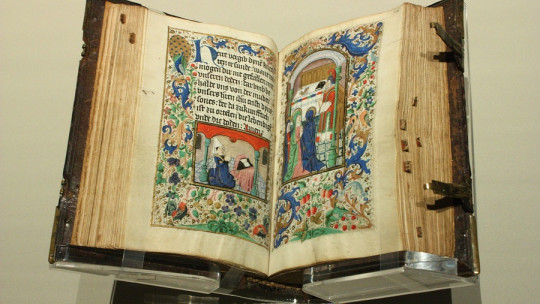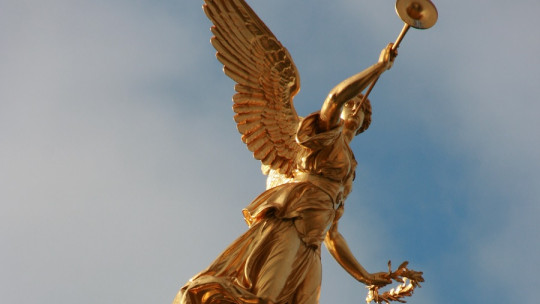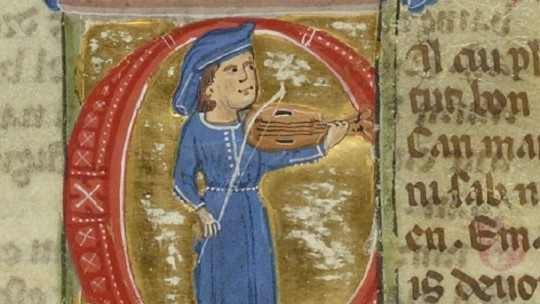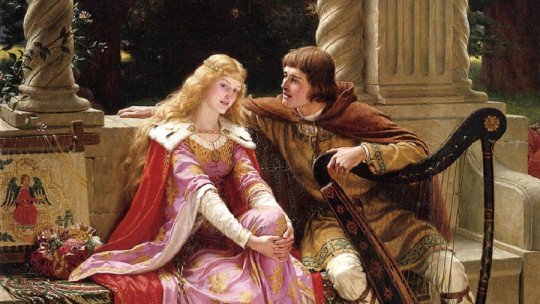
Medieval literature is the great unknown It is not at all usual for someone to have medieval authors among their daily readings. Perhaps it is because the literature of the Middle Ages is incomprehensible to us due to the effect of time; Indeed, their literary models are quite far from what we are used to, and also, of course, the mentality that their literature reflects.
In this article we will carry out a brief tour of the different literary genres that filled the medieval centuries: from historical chronicles to the poems of troubadours, through the lives of saints and novels of chivalry. All this taking into account that what we call the Middle Ages is a period that is too extensive to compress all its literature into a few pages. But let’s try it.
Characteristics of medieval literature
As always when we talk about the Middle Ages, it is difficult to establish characteristics that summarize the literature of this period. We insist: the Middle Ages are no less than 10 centuries and, obviously, in such a long period of time we find various political, economic and social contexts that contributed to shaping a specific cultural expression.
Roughly, We could divide medieval literature into two major currents: religious literature and secular literature As the name itself indicates, the first draws inspiration from Christianity: lives of saints, poems of exaltation of the Virgin or God, sacramental autos, etc. As for the second, it is exemplified in the minstrels, the troubadours, the poems of courtly love and the novels of chivalry. We must not forget, however, that nothing is black or white and that we find many works that mix both currents, such as the famous Cipriano’s Dinnerwhere the author transmits a Christian moral through secular resources such as humor, satire and the grotesque elements typical of Goliard literature.
It is important to highlight that many of the medieval literary works are anonymous, especially those that are included in the profane current. In the Middle Ages, the concept of “artist” or “author” does not exist; Just as painters did not sign their works (at least, in the first centuries of the Middle Ages), neither did the authors of epic poems or love poetry.
Perhaps now it seems strange to us that an author does not claim authorship of his creation, but we must place ourselves in the mentality of the time. The artist and the author were servants of the public ; What was important was not the creative act, but the benefit that this creation gave to whoever saw it, read it or listened to it.
We are going to see in more detail the origins of each of these literary genres and who are, as long as they are known, the representative authors of each of them.
Literature in the first medieval centuries
The belief (on the other hand, so sadly widespread) that in the first centuries of the Middle Ages literature experienced a decline is absolutely false. Could not be farther from the truth. The first medieval centuries are extraordinarily rich in literary production ; Authors such as Saint Augustine (354-430), Isidore of Seville (556-636) or Bede the Venerable (673-735), permeated the era with very important literary works.
However, we should not apply our current concept of “literature” to the works of these authors, since they are not literary fiction, but rather treatises on history, politics, religion, and philosophy.
Of Saint Augustine of Hippo we must point out, without a doubt, his famous The city of God, whose writing took him no less than fifteen years and in which he establishes the parallels between the heavenly city and the earthly one. It is a complex work that deals with themes such as death, divine nature, time or providence.
On the other hand, both Isidore of Seville and Bede the Venerable were characterized by give impetus to historical, “non-fiction” literature, as we would call it today. In fact, the History of the Goths of the first and the Ecclesiastical history of the English people The second are clear examples of the will that existed among the intellectuals of the Early Middle Ages to record the events they were experiencing.
The historical chronicle
Indeed, in those years, chronicles and historical accounts were the order of the day. We have already cited Isidore of Seville and Bede the Venerable, but we also have other chroniclers such as Gregory of Tours (538-594), author of the History of the Franksand Paulo Orosio (385-418), whose masterpiece Stories against pagans It combines, as is customary at the time, truly historical passages with elements taken from the Bible.
Another of the medieval historical chronicles that deserve to be reviewed is the Albeldense Chronicle, written by Vigila, Sarracino and García, monks from the monastery of San Martín de Albelda (La Rioja). This work is a description of historical events that range from the biblical origin of the world to the reign of Alfonso III and which ends in the year 883. It may seem strange to us that a chronicler extracts data from the Bible, but we must take into account that, For the mentality of the time, the biblical sources were part of the history of humanity and a history of the world was not conceived without starting from Creation.
Obviously, the genre becomes an instrument of propaganda in the hands of kings and emperors. Thus, Eginald of Fulda, biographer of Charlemagne, impregnates his Vita Karoli Magni (“Life of Charlemagne”) of praise to his emperor. Eginald was a monk from the Fulda monastery who moved to Aachen, the capital of the Carolingian Empire, to work as a teacher.
There he was lucky enough to be taught by Alcuin of York, the great intellectual of the time. The monk formed a close friendship with Alcuin and the other wise men who formed the “new Athens”, as Charlemagne called his Aachen court. Charlemagne was a monarch who, despite being (according to legend) illiterate, was very interested in resurrecting the greatness of Rome and Athens in his capital. In this cultural context (which Jean-Jacques Ampère already called in 1832 Carolingian Renaissance) arts and literature flourish in an extraordinary way
Thus, we have that, in the first medieval centuries, historical chronicles, biographies of famous people and, of course, works of philosophy and religion abound. Because let us not forget either that in the Middle Ages philosophy was never left aside. Medieval intellectuals greatly appreciated the classical legacy (in fact, Platonism acquired unprecedented strength with the School of Chartres), and a great desire to access the understanding of God through human reason can be seen in all of them ( which, after all, is divine creation).
Hagiographies or the lives of saints
Another of the genres par excellence of these first medieval centuries are hagiographies, that is, stories that collect the lives of the saints His main objective was, of course, moralizing; They intended to instruct the reader about the benefits of following a righteous and pious life, based on the lives of Christian saints. One of the best-known hagiographies (actually, a compilation of them) is the Golden Legend (13th century), by Santiago de la Vorágine, which had a huge impact on Western culture and established many of the guidelines for the representation of sacred scenes until the arrival of the Counter-Reformation.
The original text of The Golden Legend It collects the lives of some 180 saints of Christian martyrology. The author’s sources are various, and range from Saint Augustine of Hippo to Gregory of Tours, passing through the gospels, both canonical and apocryphal.
The revival of secular literature
During the first centuries of the Middle Ages, culture was monopolized by the Church All the authors that we have mentioned in the previous section, without exception, belong to the religious establishment. Saint Augustine was a priest and was later named bishop; Isidore of Seville was archbishop of this city; Bede the Venerable was a monk of the Benedictine monastery of Saint Peter in Wearmouth, and so on. The cultural centers par excellence were the cathedrals and monasteries. In the latter, the monks dedicated themselves to the task of copying and minimizing codices on various themes (not only religious).
It is often taken for granted that, in the early medieval centuries, secular literature barely existed. And the truth is that, if we stuck to the existing testimonies, we would have to conclude that this is reality. However, it would be quite absurd to think that the town remained silent for no less than four centuries. To consider secular literature as non-existent in the Early Middle Ages is to not know the reality of the period, since how could there be written testimonies from a social class that did not know how to write?
Orality was, therefore, one of the basic characteristics of popular expression Another of its characteristics is the use of Romance languages, that is, those derived from Latin. Thus, while intellectuals continued to use Latin as a vehicle for literary transmission, the people composed their stories in their vernacular languages. This is how romances are born.
Romances and songs of deed
We call romances the narrative songs, composed in the Romance languages (hence their name), that tell stories known to the public and that, for this reason, are repeated from generation to generation. This oral repetition obviously involves certain modifications in the original compositions.
In the Hispanic case, this type of popular songs of medieval origin began to generate interest in the 15th century, since Renaissance humanism considered them a unique expression of popular spontaneity before the “corruption of civilization.” Its compilation and subsequent publication then began. So, compositions that had survived to this day orally, finally found a fixation in writing
As we have already noted, the romance poetically narrates a historical fact and a legend, generally related to the exploits of a famous person, a battle or the birth or marriage of a king. This story may be known to the public or constitute news; In this case, the romance serves as a newsreel. Following Wolf and Hofmann, romances can be classified into two large groups: historical romances and invention romances. Within the latter we find chivalric romances and novel romances, with a high degree of fiction. One of the best-known examples, at least at the Hispanic level, is the Song of Mio Cidcomposed by an unknown author or authors around the year 1200 and which relates, quite freely, the life and exploits of Rodrigo Díaz de Vivar, better known as El Cid Campeador.
It must be taken into account that people did not want true news; what they wanted was fantasy and epic. Thus, despite the obvious news function of romances, In almost all of them we find important doses of invention, the product of the minstrel who recited them in the villages and cities
Although the romances are a product of the people, the language used is halfway between vulgar and cult language. In this way, we find in the romances stylistic resources of great beauty that increase their ability to impress, without losing even a bit of their simple and easily understandable language. On the other hand, one of the resources present in the romance is repetition, which allows rapid memorization by the minstrels and facilitates its transmission.
novels of chivalry
In the middle of the Middle Ages they gained great popularity the so-called novels of chivalry, prose stories that narrated the exploits of a knight Unlike popular romances, this type of literary work, although profane, is written by characters from high classes, who tend to be invariably cultured.
Thus, for example, one of the greatest exponents of the genre, Chrétien de Troyes, was a man well versed in classical culture. Little is known about his life; Before professing in a monastic order, he carried out literary works for great lords such as Mary of France or Philip of Alsace. Precisely, one of his best-known novels is dedicated to the latter, Perceval either the Grail Talestarring the Arthurian knight of the same name.
Chrétien de Troyes has often been called “the father of the Western novel” (with Cervantes’ permission) and, although it may be an exaggerated statement, he is not without reason. As Martín de Riquer points out in the prologue of the Austral edition of Percevalthe novels of this author are not only a brief narration of the knight’s adventures, but we also find an excellent characterization of the characters, as well as some beautiful descriptions that, on the other hand, testify to the poetic richness that characterizes the century XII.
In general, chivalric novels, in addition to presenting the adventures of a knight, They were a moral teaching for the reader Through the adventures of the knight in question, values such as temperance, strength and charity are reinforced. On the other hand, the chivalric novels did not claim any historical fidelity; sometimes, not even geographical. Medieval heroes move through fantastic and imaginary realms and relate to characters who have little or nothing to do with reality. Finally, it is necessary to highlight that this type of stories are framed in centuries dominated by courtly love, in which the knight serves a lady, usually married, whom he idolizes in an extreme and, often, in a certain masochistic way. . We will see this ideal of suffering for love, so characteristic of the time, in more detail in the next and final section.
Courtly love, minstrels and troubadours
The 12th century is the century of love and gallantry. It is at this time where the so-called courtly love gains strength, a genuine expression of love and the desire to live As Paul Zumthor perfectly illustrates in his introduction to one of the editions of the letters of Abelard and Heloise: “The courtly scheme completely escapes the scholastic tradition.”
The term “courtly love” is quite recent, since it began to be applied in the 19th century in reference to all this literature starring ladies, troubadours and minstrels. In the Middle Ages the term “Fin’amor” was used in the language of oc; that is, “refined love,” “pure love,” which was distinguished, in this way, from “bad love.”
Why was courtly love considered “pure love”? Because it was a strictly platonic relationship that was established between the lady and her lover, who composed for her. Generally, and to add a tragic note to the story, the lady was usually married, which made her even more inaccessible. That is why medieval troubadour poetry abounds with the cries of poets who lament the impossibility of accessing the woman they sing about. Among these sad poems, the “albas” stand out, where the poet expresses his deep pain when, at dawn, he must say goodbye to her beloved, since she must return to her husband. Generally, these nocturnal carnal relations were an invention of the troubadour (although we do not rule out that, on occasion, they took place).
The summation of courtly love comes from the hand of authors like Dante and Petrarc because, already in the 14th century, they made their compositions framed in the so-called Sweet new style (sweet new style). In the Divine Comedy and in the Vita Nuova of Dante, as well as in the Songbook of Petrarch, we find continuous allusions to the lady as a vehicle of transcendence and spiritual union.








